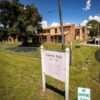January 15, 2015. The Columbus Dispatch.
 ADAM CAIRNS | DISPATCH PHOTO Loewendick Demolition Contractors work to tear down the chimney from 1239 Summit Street in Weinland Park before bulldozing the entire house.
ADAM CAIRNS | DISPATCH PHOTO Loewendick Demolition Contractors work to tear down the chimney from 1239 Summit Street in Weinland Park before bulldozing the entire house.
Yesterday, men and machine brought down a three-story brick house in Brandyn McElroy’s neighborhood, work reflective of an aggressive push by the city and county to demolish vacant, blighted houses.
“It’s definitely making a difference,” said McElroy, the president of the Weinland Park Community Civic Association.
“The house they’re tearing down today is next door to where I live. It caught fire a couple of weeks ago. The structure is beyond repair.”
An unprecedented number of similar houses came down across the county last year.
The Columbus and Franklin County land banks demolished 1,294 blighted housing units in 2014, more than double the number of teardowns performed in 2013. The cost of the demolitions in 2014 was $10.2 million.
The work was helped in part by $8.6 million in grants from the Ohio attorney general’s office to demolish vacant and blighted units in 2013 and 2014. Franklin County and the city of Columbus provided matching funds.
In 2013, the land banks tore down 527 housing units, most of which were in Columbus’ central-city neighborhoods.
More demolitions are on the way. Early last year, the Ohio Housing Finance Agency gave the two land banks a $5.9 million grant to tear down a total of 300 additional units through 2016.
And more demolitions will be funded by Columbus and the Central Ohio Community Improvement Corporation, which serves as the county’s land bank.
Curtiss Williams, vice president of the community improvement corporation, said the housing finance agency grant must be used in areas that are considered to be at the tipping point. In this case, that will be parts of Franklinton, Linden, the South Side and the Near East Side, plus Whitehall and parts of Mifflin and Franklin townships.
Williams said these are residential neighborhoods that generally have many owner-occupied houses, with less than 20 percent of all houses considered to be blighted. But these neighborhoods are seeing rising numbers of vacant houses and falling values.
Most of the houses demolished so far have been in older sections of the city and county. Some have attracted squatters and crime while depressing property values and tax revenue.
Columbus Mayor Michael B. Coleman wants to continue to concentrate efforts in neighborhoods that struggle with large numbers of vacant houses.
In 2012, Coleman pledged $11.5 million over four years to demolish 900 vacant houses in the city.
John Turner, who directs the city’s land redevelopment office, expects the last $2.5 million in this year’s capital budget will complete the project.
Although thousands of properties have been demolished, 81 houses in the city land bank were sold last year, and about 85 percent of them were single-family houses.
Curtis Davis, vice president of the Columbus South Side Area Commission, said the demolitions are opening sites in his community for new housing. “I think it’s definitely making an impact,” he said.
Williams said neighborhood leaders and residents are starting to understand the gravity of the issue and what the land banks can do.
“It’s important to remove a blighted property,” he said. “The market can come in and take care of that property.”





